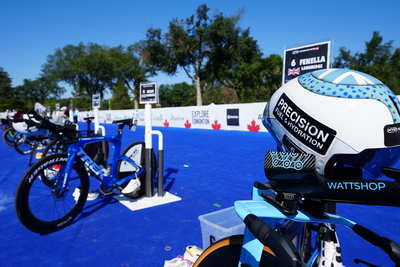With so many incredible locations to swim, bike and run against the clock, we’re seeing a growing number of amateur athletes travelling abroad for races again.
While the fourth discipline of triathlon is often said to be the transitions (or fueling for long distance racing), I’d argue that the fifth discipline when going overseas would be the 'art of packing' for race day.
So, let’s take a look at five ways you can become the Picasso of packing…
Look after your bike
Bike cases and boxes are expensive, but so are new bikes. When flying with your bike, you should look to get a case or box that you know will protect your bike against the luggage trolls. This means a case that is crush resistant and holds the bike in place so it can’t move around whilst in transit.
For a time, soft cases were the go-to for ease of dismantling and assembling, but too many horror stories have been told. Find something solid with rigidity on the outside and stability on the inside.

Don’t take the kitchen sink
Spare chain, spokes, pedals, bolts, inner tubes, tires, bar tape, bottle cages, and all the tools that go along with it are nice to have, but they’re also heavy when all together.
Additional weight is costly when travelling by plane, so get your luggage as light as possible and prioritise the essential weighty items, namely race fuel and kit.
Before flying, check the area’s local bike shops for parts you may need, which will give you peace of mind that if something does go wrong you can get it fixed.
A few clever bits to take with you are a multi-tool for assembling your bike, zip ties and electrical tape for anything that could possibly go wrong, chain lube, pedal spanner, chamois cream, and last but definitely not least, a travel size track pump.
Use your kit wisely
Kit is not only useful for the race (obviously) but also for packing around your bike to protect it. Shoes between forks and a wetsuit around the top tube is a good idea.
You can also stuff things like gels and drink powders into bottles, which not only saves space but adds to the case’s rigidity and stability. The other bonus to filling your bottles with gels is if you use gels that are prone to splitting open, then you won't end up with a sticky mess all over your clothes!
Learn how to assemble your bike
Yes, you can book it into a shop or the expo mechanic but you will pay for it in cash and mistakes. If you’re truly a non-mechanical person, then booking your bike into a shop is a good idea but you do need to be sure you take responsibility for checking it. Headset bolts, chain bolts, pedals and bottle cages all like to come loose.
On race week, the mechanics will do over 500 bikes in three days, so they’re likely to be tired and rushed – don’t count on them to be perfect (trust me here, I used to be a race mechanic!).
Your local bike shop should be more than happy to show you how to break down and build back up your bike for travel. Record videos and learn!
Use a cube packing method
Packing cubes are epic and if you don't know about them, then immediately stop reading this and find them!
All you need is four or five cubes and a list for each one. Write down what needs to go in each cube, then get packing and simply put the packed cubes into your case or bag. This way of packing stops you forgetting things as you categorise the cubes.
- Racing and training kit
- Trousers and long sleeves
- Shorts and t-shirts
- Socks and underwear.
These are my four categories as my bag has an in-built section for shoes, but if yours doesn't then you can make that your fifth. I also do the same for electronics and cables, but in my hand luggage.
When you categorise things, you can work through it methodically. I go head-to-toe for items of clothing and obviously keep the weather in mind!
That's it then, you’re ready to travel to your next race! Oh, and don't forget your Garmin charger… or your Garmin.
